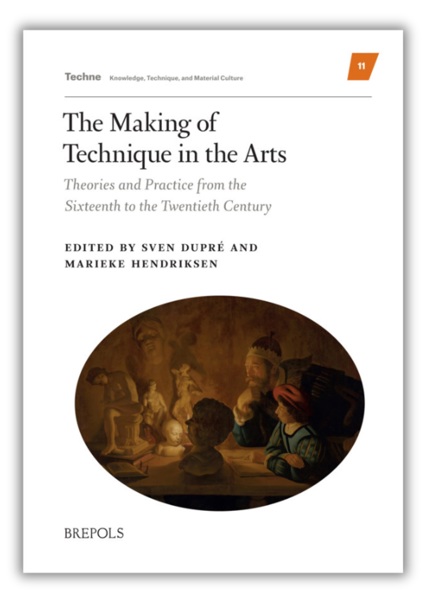
The Making of Technique in the Arts
Theories and Practice from the Sixteenth to the Twentieth Century
Sven Dupré, Marieke Hendriksen (eds)
- Pages: 206 p.
- Size:178 x 254 mm
- Illustrations:35 col.
- Language(s):English
- Publication Year:2023
- € 80,00 EXCL. VAT RETAIL PRICE
- ISBN: 978-2-503-59899-4
- Hardback
- Temporarily Out of Stock
- € 80,00 EXCL. VAT RETAIL PRICE
- ISBN: 978-2-503-59900-7
- E-book
- Available
This book explores the linguistic, philosophical, and pedagogic history of technique in the arts, answering the question why the term ‘technique’ first emerged around 1750, and exploring how its meaning to artists, art theorists, and natural philosophers changed until the twentieth century.
Sven Dupré is Professor of History of Art, Science and Technology at Utrecht University and the University of Amsterdam. He is PI of the ARTECHNE project ‘Technique in the Arts: Concepts, Practices, Expertise, 1500-1950’, supported by a European Research Council (ERC) Consolidator Grant. Since 2018 he also heads the NWO Smart Culture Art DATIS project on the history of glass.
Marieke Hendriksen is a historian of art and science, working on the intersections of the history of ideas and material culture of medicine in the long eighteenth century, and has published widely on material culture and technical skill in eighteenth- and nineteenth-century medicine and chemistry. She is a researcher at the NL-Lab of the Royal Netherlands Academy of Arts and Sciences (KNAW), and is co-leader of the NWO Smart Culture Art DATIS project on glass history.
What is technique in the arts? Now widely used to refer to the practical aspects of art making, ‘technique’ was a neologism in the vernacular, and started to appear in treatises on arts and sciences from around 1750. Rooted in the Greek technè, which was translated routinely as ‘art’ until the mid-eighteenth century, technique referred to processes of making or doing and their products. Described previously as ‘art’, ‘methods’, ‘manners’ or ‘mechanics’, techniques were recorded in text with the intention of documenting or transmitting practical skills and knowledge. This book bridges the gap between the changing concept of technique and the practices currently described by it. It explores the linguistic, philosophical, and pedagogic history of technique in the arts, answering the question why the term ‘technique’ first emerged around 1750, and exploring how its meaning to artists, art theorists, and natural philosophers changed until the twentieth century.
1. Introduction
Sven Dupré & Marieke Hendriksen
2. The Body and Daily Life as Metaphor and Analogy in Technical Language in the Works of Leonardo da Vinci, Vannoccio Biringuccio and Benvenuto Cellini
Andrea Bernardoni
3. Neudörffer's Notebook: Recipes and the Rendering of Calligraphic Technique between Manuscript and Print in Sixteenth-Century Germany
Hannah Murphy
4. Between arte and ingenio. Approaches to Technique in Early Modern Spanish painting
José Ramón Marcaida
5. ‘An old and calm woman, blind and mute’: Finding Words to Describe Technique in Dutch Seventeenth-Century Art Literature
Marije Osnabrugge
6. ‘Have a great care of the shadows’. Perspectives on Carefulness in Historical Recipes for the Restoration of Oil Paintings.
Maartje Stols-Witlox
7. Architecture and Technical Virtuosity in Eighteenth Century France
Valérie Nègre
8. The Debate about Technique in the Kunstwissenschaft around 1900
Maria Teresa Costa
9. Somatic Language in Artistic Work Practices. An Ethnographic Perspective on Bodies, Materials, Practical Knowledge and Technique in Contemporary Art
Christiane Schürkmann




